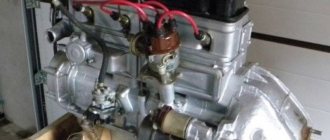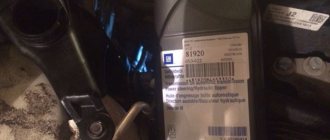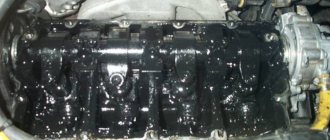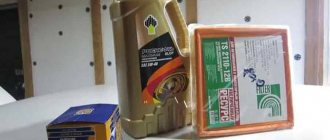The efficiency of a car engine lubrication system depends not only on the serviceability of its elements, but also on the quality of the lubricant. Its main task is to cool and lubricate the moving parts of the power unit, reducing friction.
In addition, the oil must also clean the lubricated surfaces from the products of this friction, as well as deposits formed during the combustion of fuel.
In this article we will look at which oil is most suitable for use in the engines of VAZ-2170 Priora cars.
Why is replacement needed?
Any motor lubricant is designed for a certain resource, after which it will begin to lose its properties.
These properties are associated not only with its viscosity, but also with its cleaning abilities. In other words, oil that has exhausted its specified life will not be able to cope with its tasks. Over time, this will lead to constant overheating of the engine, clogging of the oil channels through which it flows to the rubbing elements, as well as the formation of deposits on the surfaces of the piston group parts. Naturally, no one needs such problems, so it is customary to change the oil after a certain period, expressed either in thousands of kilometers or in the time equivalent.
When to change
According to the factory's recommendations, it should be replaced after the first 2.5-3 thousand kilometers (for a new car), and then changed every 7-10 thousand km, or every six months. It is better to stick to the last interval, changing the lubricant twice a year, observing seasonality.
For warm periods - summer oil (higher viscosity), for cold periods - winter oil (lower viscosity). However, most Prior owners use all-season oils without complaining about the consequences.
Contrary to the popular belief that the lubricant needs to be changed by changing its color to a darker one, regardless of the season and mileage traveled, this should not be done. Darkening of the oil only indicates that it is flushing out unwanted deposits, keeping the engine clean from the inside.
Choice
Which is better: synthetic or semi-synthetic? This is an eternal dispute that will never be resolved. Car owners who pour synthetic lubricants into their Prioras claim that the engine runs much smoother and easier, and that oil won’t spoil the porridge.
Other “priorists” - adherents of semi-synthetics, insist that synthetic oils, due to their properties, are not suitable for their cars, since it often happens that the lubricant “leaks” through oil seals that are not suitable for it.
In fact, the oil has nothing to do with it. Lubricant leakage through the seals can occur for completely different reasons, for example, due to a manufacturing defect or increased pressure in the system.
As for the plant's recommendations, they clearly prescribe the use of semi-synthetic oils for gasoline engines corresponding to groups SJ or SL , provided for by the API classification. "Priors" leave the assembly line with semi-synthetic production oil poured into the engine.
Violation of the manufacturer's recommendations for a car that is under warranty and undergoing mandatory maintenance may result in termination of warranty service by the company that sold you the car. If your Priora is not under warranty, you can safely use synthetics, the main thing is that it is of high quality.
Oil viscosity
The viscosity of engine oil is selected for certain temperature conditions of its operation. If you plan to use oil seasonally, and, for example, fill it with winter oil, then you should focus on the minimum design temperature.
In other words, if the machine will be operated at a temperature of minus 35-40 degrees, the oil viscosity class according to SAE must correspond to 0W or 5 W. If the design temperature is minus 25 degrees, a lubricant of class 10 W should be filled in, if minus 20 degrees - 15 W, minus 15 degrees – 20W, etc.
For summer oils, the classification method is retained. The numbers on its marking also indicate the viscosity in ascending order. For example, SAE 20, 30, 40, 50, 60.
If you want to use all-season oil, then lubricants of the following specifications are recommended for Priora, depending on the temperature conditions:
- 20W40: from -15 to +45;
- 15W40: from -20 to +45;
- 10W40: -25 to +35;
- 10W30: -25 to +25;
- 5W40: from -30 to +35;
- 5W30: from -30 to +25;
- 0W40: -35 to +30;
- 0W30: -35 to +25.
Volume and price
The Priora engine holds 3.2-3.4 liters of engine oil, i.e. You will have to buy a standard four-liter canister. As the engine operates, it will slowly “eat up” the lubricant, but this is not a problem if no more than 100-250 ml is spent on “waste” per 1000 km. This is par for the course. But if the engine consumes more than this figure, you will most likely have to do a major overhaul.
The cost of a canister of oil depends on its type and manufacturer. For example, 4 liters of all-season semi-synthetics from Lukoil or Rosneft will cost about 1,200 rubles. Synthetics cost 100-300 rubles more. Shell or Mobil of the same volume will cost 1200-1600 rubles.
Which oil filter to choose
The choice of filter depends primarily on your preferences and financial capabilities. Today there are quite a large number of oil filters on the market.
- Oil filter 2108-1012005-010 (Salyut) factory - price from 150 rubles
- Oil filter W914/2 Mann price from 240 rub.
- Oil filter SM 101 SCT price from 180 rub.
- Oil filter GB-102 M BIG (Russia) price from 180 rub.
- Oil filter AB2108-1002005 AutoReal price from 130 rub.
If we talk about the most popular options, then most often the Salyut or Mann filter is installed on the Priora. These filters have proven themselves over the years only from the best side.
Oil change on Priora
When changing the oil, the oil filter also needs to be replaced, so it is also better to buy it in advance. The process itself is quite simple and does not require the intervention of specialists.
Work order:
- It is better to install the car on an inspection hole or overpass. The engine should still be warm - this will allow the oil to drain faster.
- With the hood open, unscrew the filler cap.
- If your vehicle is equipped with an engine guard, it will have to be removed to get to the drain plug.
- After removing the protection, wipe the drain plug with a rag.
- Using a 17 key, unscrew the plug on the oil sump, not forgetting to place a previously prepared container under it.
- Wait until all the oil has drained and screw the plug back on.
- Using a special puller or simply by hand, unscrew the oil filter. If you don’t have a puller and you can’t do it by hand, pierce the filter housing with a screwdriver and use it to unscrew the filter.
- Pour new oil into the opening of the new filter until it is full. This is necessary to ensure that no air gets into the system when starting the engine. Also lubricate the filter O-ring with oil.
- Screw the filter ¾ turn.
- Pour new oil into the engine filler neck, focusing on its level on the dipstick.
- Start the engine and let it run for a while. Recheck the oil level.
- Make sure the drain plug is screwed on tightly and does not leak oil.
- Reinstall the engine protection.
Oil class.
- Mineral oil.
The most inexpensive, but also the least quality oil. The main disadvantage of mineral motor oil is the loss of lubricating qualities when rubbing parts are heated and deterioration of characteristics over time. Another disadvantage is poor cleaning properties, which leads to rapid engine contamination.
.
The most expensive, but high-quality oil, known for its best anti-friction properties and resistance to temperature changes. Winter brands of synthetics are characterized by high fluidity and low evaporation.
- Semi-synthetic motor oil
The most popular oil among car enthusiasts. The viscosity index of semi-synthetic oil is higher than that of mineral oils. The quality of semi-synthetics is comparable to the characteristics of synthetic oil, and the price is significantly lower.
- Hydrocracking oil or HC synthesis oil.
It differs from other oils in its highest temperature-viscosity characteristics (viscosity index 130-170), but at the same time the cost is lower than that of semi-synthetics. They have high compatibility with additives and do not corrode rubber seals in the engine system, which is especially important for older VAZ models.
Rating of the best motor and transmission oils for Lada Priora
| Category | Place | Name | Rating | Price |
| The best synthetic motor oil for Priora | 1 | Motul 8100 X-cess 5W40 | 9.5 / 10 | 3 500 |
| 2 | LUKOIL Genesis Armortech 5W-40 | 9.4 / 10 | 2 550 | |
| 3 | ZIC X9 5W-40 | 9.3 / 10 | 2 000 | |
| The best semi-synthetic motor oil for Priora | 1 | LUKOIL Lux 10W-40 | 9.7 / 10 | 1 100 |
| 2 | MOBIL Super 2000 X1 10W-40 | 9.6 / 10 | 1 410 | |
| 3 | TOTAL Quartz 7000 10W40 | 9.4 / 10 | 1 900 | |
| The best mineral motor oil for Priora | 1 | Mannol Universal 15W-40 | 9.4 / 10 | 2 250 |
| The best synthetic gear oil for Priora | 1 | ELF Tranself NFJ 75W-80 | 9.7 / 10 | 460 |
| The best semi-synthetic gear oil for Priora | 1 | LUKOIL TM-4 75W-90 GL-4 | 9.5 / 10 | 300 |
| The best mineral gear oil for Priora | 1 | TOTAL Transmission Gear 8 75W80 | 9.6 / 10 | 460 |
Oil change intervals.
The first oil change is made after 2.5-3 thousand km. Subsequently, it is changed twice a year if seasonal oil is used (winter-summer) or once a year if all-season oil is used, but no later than 15 thousand km.
Attention! Changing the oil should only be done when the engine is warm, so be careful when draining hot oil.
Operating conditions and driving style.
Viscous oil with a high operating temperature (0W-50, 5W-50, 10W-50) is suitable for fans of fast driving or for participants in sports competitions.
For a new Lada Priora engine (VAZ 21126, 21117, 21128) with a vehicle mileage of up to 50 thousand km, SAE 5W30 or 10W30 oil is recommended. For an engine with a mileage of 50-150 thousand km, it is preferable to use oils: 15W40, 5W30 or 10W30 (for winter), and for all-season operation 5W40. If the engine life is from 150 to 200 thousand km, then it is recommended to use SAE 15W40 and 20W40 class oils in summer. For winter, SAE 5W40 and SAE 10W40 are suitable. SAE 5W40 is used as an all-season oil for engines in anticipation of major overhauls (over 200,000 km).
I have a deep understanding of all the intricacies of a car and have extensive experience working in a workshop. I have hundreds of repaired cars of various brands behind me, but I still do not claim to be an expert in this field. However, this article should help you in servicing your 16-valve Priora. The article also provides manufacturer recommendations and advice from experts from the automotive world.
Motor oil is needed to ensure high-quality lubrication of the shaft in the car and to lubricate the cylinders in the engine, as well as to process many other elements of the car. Lubrication makes it possible to significantly reduce the overall rate of friction while the car is moving and while its engine is running, even at full power. For this reason, the operating time of the motor and other components increases. In addition to all of the above, the lubricant promotes effective engine cooling in any weather.
Remember that for a Lada Priora with a 16-valve engine, like for a Priora of any other model, the engine oil must be changed. At the same time, choosing the most suitable liquid is always very difficult.
Manufacturers
Today, the choice of oil manufacturers is quite large. It is worth choosing products from European and Russian manufacturers. Their products combine quality and reliability. The following oils are in greatest demand among Priora owners:
- Lukoil;
- Mobil;
- THK-Magnum;
- Castrol;
- XADO;
- Shell with index 10W-40 and 5W-40.
At the manufacturing plant itself, semi-synthetic Lukoil is poured into the LADA Priora car.
In general, domestic brands of liquids are not inferior in their characteristics to foreign ones; they are manufactured according to international standards. But mixing oils from different manufacturers and brands is prohibited. In case of switching to another lubricating fluid (or if the brand of oil filled by the previous owner is unknown during replacement), the engine is first washed with special compounds.
How much lubrication is required
Any motorist needs to understand what kind of oil is recommended to use in his Priora and exactly how much of it should be filled. To do this, the driver must read the maintenance book for his car and follow the instructions in it. But it still happens that this document cannot be found. In such a situation, it is better to take the advice of repairmen.
The amount of liquid that you fill during replacement is on average about 3 liters. Experienced specialists will tell you a more accurate parameter. But at the beginning it is recommended to fill in approximately 3.2 liters of the substance. After this, the Priora is started and turned on for a few minutes, then it is worth measuring the amount of lubricant.
How to do it? All measurements should be carried out using a probe. The average and most suitable for the operation of a Priora car with a 16-valve engine is the indicator at which this mark is located between the highest and lowest parameters. If this mark does not reach the normal value, it is worth adding more liquid. It is also recommended to take into account that the amount of lubricant poured into a Priora car should not exceed the maximum value.
You need to buy oil in a 3-4 liter container, which will make it possible to add additional lubricating fluid if necessary.
Some tips
You should not judge the quality of a product only by its color.
After all, it is determined by the added additives. Therefore, the liquid can be either dark or light. Before purchasing, read reviews from Priora car owners and listen to their advice. It is best to buy motor oil in official stores, since the number of counterfeits in stores, markets and gas stations is quite large. Therefore, manufacturers try to protect their products in various ways. Thus, XADO brand oil has a specific caramel smell, and other manufacturers apply special protective holograms to the container or box.
What oil to use in Priora 16 valves
Many Priora owners are interested in: what lubricant should they use? Oils for cars can be of a synthetic type (obtained by chemical synthesis), as well as mineral (they are made by distilling oil). This type of lubricant is much less preferable for pouring into Priora, since this lubricant quickly loses its properties and changes its chemical composition during operation. Also, this type of lubricant contaminates the motor and makes its operation more unstable.
To lengthen the time intervals between engine servicing, it is recommended to use synthetic oils. In principle, you should not mix several types of oils. But still, in rare cases, this can be done if you are stopped on the road and do not have the opportunity to purchase a similar product here and now.
Remember that for the 16-valve Priora engine it is best to buy synthetic lubricant of the highest quality.
If you have financial difficulties, you can purchase standard semi-synthetics.
- Motor oil Lukoil 10W-40 This oil has many awards and is generally of quite high quality in its essence. The product is ideal for your Priora with a 16-valve engine and fully meets the standards indicated on the bottle. The product is of excellent quality and has a positive effect on the Priora engine, and was also able to establish itself at a sufficient level in the market. Lukoil series can improve driving characteristics. The motor lubricant of the series has proven itself to be beneficial when working in the most dangerous conditions.
- Lux is an equally effective option for the Priora engine. The oil has received many awards from various competitions, and if you are on the side of the latest achievements of the chemical industry and want the best product for your Priora, which has won numerous awards, then you should pay attention to Lux lubricants. What are the advantages of such motor oils? The company's lubricants contain many additives that can distinguish this oil from products of equal price.
- Rosneft Premium motor oil is the choice for those who want to keep their Priora in perfect working condition. This product can effectively compete with many brands - the lubricant has the best properties in cold weather and has proven itself well in hot weather, thanks to new additives. Replacing your current motor lubricant on a Priora with a 16-valve engine with a Rosneft Premium series is appropriate even in the most dangerous weather conditions. The product is not afraid of strong temperature changes. The oil of the series almost does not emit harmful vapors and does not evaporate into the atmosphere, therefore, lubricant replacement is postponed for 2-3 thousand kilometers.
- Shell Helix. Shell is one of the leading companies producing automotive lubricants. Shell oil production technologies are classified, but let's just say that the line of oils from Shell is definitely suitable for use in the Lada Priora engine.
Should I use synthetics?
The 16-valve engine installed on the Lada Priora is capable of accepting various types of lubricant. In addition to standard semi-synthetics, some motorists use synthetic lubricants. As practice shows, there are no problems with burnout and damaged oil seals. Also, synthetics perform better in severe frost conditions. The engine starts working at lower temperatures when compared with VAZ recommendations.
Owners of Lada Priora often ask the question - which synthetic oil is better to buy? If you want the power plant to work as expected, you will have to spend money on imported high-quality fluids. Of course, you need to follow the recommendations when choosing synthetics. There is no point in pouring mineral oil into the Priora; it simply will not perform its functions in a 16-valve engine.









